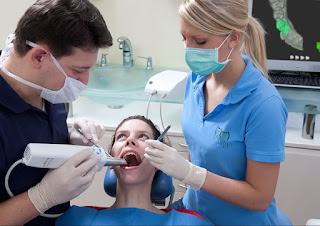Right Now
Digital Orthodontics Market is expected to grow at CAGR of 18% and to reach a revenue of $6.20Billion by 2023.
America leading with major share in the Digital Orthodontics Market
On a geographic level, American regions are the dominant player in the market with a 62% market share, with a large portion of it being held by the US, followed by Canada. America generated revenue of $1.33 billion in 2017. The market for America is expected to grow at a CAGR of 16.6%, and to reach a value of $3.35 billion by 2023.
The European region with its EU5 countries such as Germany, Spain, and Italy, holds 25% market share. The European market is anticipated to grow at a CAGR of 19.3%, to reach a revenue of $1.67 billion by 2023. The APAC region will exhibit a high growth rate of 21.5% and is projected to be worth $946.88 million by 2023.
Selected Technology Analysis done in the full Report:
The global digital orthodontics Business includes intraoral scanners, intraoral cameras, and 3D printers. Among all, intraoral scanners account for a majority of the revenue in the Global Digital Orthodontics market, contributing approximately 68%. The market for intraoral scanners estimated to grow at a CAGR of 18.5% from $1534.2 million in 2017 to reach $4245.34 million by 2023.
Growing disposable incomes, raising awareness of facial aesthetics and insurance coverage makes this market to grow at a higher rate. With the increasing attention to smile aesthetics and other Orthodontic procedures, Orthodontists across the globe use Intraoral Camera to devise the best treatment available for each patient. North America is the leading one in intraoral cameras to generated revenue of $36.9 million in 2017 and is estimated to grow at a CAGR of 4% to reach $42.98 million by 2023. The 3D printers market is estimated to grow at a CAGR of 18.6% to reach $1671.80 million by 2023. Increase in production capacity, operational costs and faster model-making than hand milling is fuelling the growth of the market.
Excerpts on Market Growth Factors
The start-ups are developing innovative, portable and affordable digital orthodontics systems including digital photography, CAD/CAM, intraoral digital scanners and 3D printers. Such companies developing products with innovative solutions might pose a mild threat to the existing companies since digital orthodontics is still in the growth stage.
A number of companies entering the digital orthodontics market are increasing the market attractiveness. The competition is moderate due to high customer loyalty for branded products. The launch of new products and on-going development is the major factor behind long term growth of this market.
Dental instruments growing rapidly throughout the world due to ample reasons including low cost, high quality, shorter waiting time, convenient, travel opportunities, most importantly being a cost-effective alternative to the dental care offered in their own country, which will ultimately lead to the increase in the demand of digital orthodontics procedures.
To access the full report browse the link below
https://industryarc.com/Report/1326/Digital-Orthodontics-Market-Analysis-Report.html?
Key players of the Digital Orthodontics Business
The digital orthodontics market comprises of numerous companies, catering to different requirements of the end-users. The digital orthodontics market is chiefly dominated by Sirona Dental Systems, Planmeca OY, Stratasys Ltd, 3Shape Systems, 3M Healthcare and Align Technology. However, the growing number of start-ups, coupled with technological advancements will shift the market share slightly from key players to smaller companies. Sirona Dental System’s major productCerec, Planmeca OY’s product PlanScan, Align Technology Inc. product iTero with the function of scanning and patented dual aperture lens system simultaneous capture 2D images in color with highly accurate 3D laser scanning, and last but not the least,Carestream Health’s launch of CS 3500 are some of the key products functioning towards the growth of the market.
Digital Orthodontics Business report is segmented as below
A. Digital Orthodontics Industry – By Imaging Technology
1. Laser
2. X-Rays
3. White light
B. Digital Orthodontics Industry – By Technology
1. Digital Photography
2. Computer-Aided Design/Computer-Aided Manufacturing
3. Intraoral Scanners
4. 3D Printers
C. Digital Orthodontics - Industry By Usage Of Contrast Medium Prior Scanning
1. Contrast Medium Dependent Scanner
2. Contrast Medium Independent Scanner
D. Digital Orthodontics Business By End User
1. Hospitals
2. Clinics/ASCs
3. Research Institutes
4. Laboratories
E. Digital Orthodontics Industry by Geography (covers 10+ countries)
F. Digital Orthodontics Business Entropy
What can you expect from the report?
The Digital Orthodontics Industry Report is Prepared with the Main Agenda to Cover the following 20 points:
1. Market Size by Product Categories & Application
2. Market trends & Relevant Market Data
3. Manufacturer Landscape
4. Distributor Landscape
5. Pricing Analysis
6. Top 10 End user Analysis
7. Product Benchmarking
8. Product Developments
9. Mergers & Acquisition Analysis
10. Patent Analysis
11. Demand Analysis (Revenue & Volume)
12. Country level Analysis
13. Competitor Analysis
14. Market Shares Analysis
15. Value Chain Analysis
16. Supply Chain Analysis
17. Strategic Analysis
18. Current & Future Market Landscape Analysis
19. Opportunity Analysis
20. Revenue and Volume Analysis
Media Contact:
Mr. Venkat Reddy
Sales Manager
Email 1: sales@industryarc.com
Or Email 2: venkat@industryarc.com
Contact Sales: +1-614-588-8538 (Ext-101)
About IndustryARC: IndustryARC is a Research and Consulting Firm that publishes more than 500 reports annually, in various industries such as Agriculture, Automotive, Automation & Instrumentation, Chemicals and Materials, Energy and Power, Electronics, Food & Beverages, Information Technology, Life sciences & Healthcare.
More Posts



















Report This Post
Please complete the following requested information to flag this post and report abuse, or offensive content. Your report will be reviewed within 24 hours. We will take appropriate action as described in Findit terms of use.



